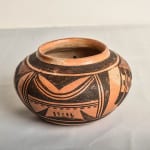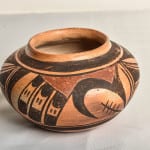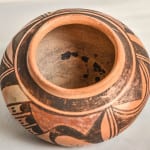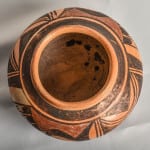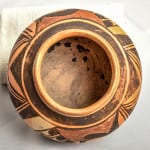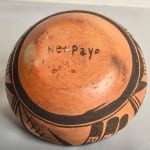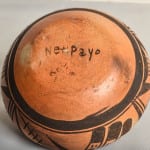This is a particularly well-formed jar and has a strong visual presence in spite of its modest size and unexceptional painting. It is included in this collection because of the signature on the bottom: “Nempayo.”
Form:
The form of jar 2015-14 is slightly bulbous, ending with a short, beautifully formed neck. As with most Hopi pots, the bottom is thickest from being formed on a puki and thins as the walls become vertical. As the walls begin to bend toward the opening, the walls are still thinner until they form the slightly out-curving lip. The thinner walls help keep the unsupported clay from collapsing while wet.
Perhaps because the mouth is so large, the inside of the jar has been carefully smoothed, though not polished. The exterior surface has been carefully polished so the marks of the polishing stone are almost invisible. The pot was outdoor fired which produced a fairly even blush, except for one light patch on the bottom.
Design:
The design is bounded by upper and lower thick and thin framing lines. Two alternating panels contain the design, each repeated twice. One panel is monochromatic black; the second contains a red element in addition to black design.
The all-black panel has a stolid unexciting format. The top half is defined by an inverted solid triangle pointing into an unpainted area containing a two-line arc. The corners of this upper half a filled in with black paint. Were this design inverted, it would be more easily visualized as the image of a black mountain spanned by a fine-line black rainbow with the upper sky also painted black. Below are two thin lines forming a two-lane “highway” and beneath the lines is a row of 11 or 12 dashes forming a broken line. The bottom elements consist of a solid black hill flanked by two triangles. Taken together these elements look a bit like the top of Batman’s hat. A very similar design is seen on the classic eagle-tail jar by Nampeyo in this collection, 2005-10. Growing out of the top of the hill are five vertical lines.
The second panel features the only red design on the jar. Attached to the left edge of this red element are three linear and parallel feathers. The base of each feather consists of a short, solid hill of black paint. The tips of each feather have slightly longer solid black tip. In between the base and tips in each feather are two short parallel lines. The most dynamic element of design on the jar lies along two other boundaries of the red area and manages to point in three directions at once. A thick pointed black curve sweeps counterclockwise into an unpainted space. The other end of this black element forms a double-pointed “Y” shape, a bit like the tail of a marlin. Floating almost freely in the unpainted space below this design is a ladder-like element consisting of a long line crossed by five shorter lines.
There is palpable tension in this second panel between the two linear motifs and the curved black element with three points. If you think in terms of the directions of a compass,
—the three linear tails point southwest;
—the ladder element points northwest;
—the curve sweeps to the left and then points southeast; and
—one point of the “tail” points northeast, the other southeast.
That’s a lot of visual tension in one small panel and this is the most visually compelling section of design. While the design on the second panel is visually interesting, the overall painting does not reflect the sophisticated design strategies of Nampeyo and was not done by her.
Signature:
For a more comprehensive review of “Nampeyo” signatures, see Appendix E.
Pots signed with the spelling “Nampeyo” are not particularly rare and were made between 1930 and 1942, the first date marking the first Hopi Craftsman Show at the Museum of Northern Arizona and the last date marking Nampeyo’s death. In between Nampeyo continued to form pottery although she was functionally blind and her daughters or a female relative painted them. The signature on the bottom was added by a relative and functioned like the “Made by Nampeyo – Hopi” stickers used by the Harvey Company to promote this celebrated potter and command a premium price.
The unusual spelling “Nempayo” on pot 2015-14 may have a rich story to tell, as might the irregular signatures “NAMpyuo” on the bottom of bowl 2012-25. and the “”NAMPEyuo” on pot 2019-18.
I believe these irregular spellings were early attempts by the relatives who painted Nampeyo’s pots to indicate her name. Since Hopi is not a written language, the painters tried to translate the sound of Nampeyo’s name into english, with varying results. I suggest that only after the Museum of Northern Arizona required the signing of pots for their 1930 Hopi Craftsman Show, did the spelling of “Nampeyo” become standardized. See Appendix E for the full discussion.
Such detail was without importance to the artists who fashioned these bowls. My intensity about such information has been a regular source of amusement to the Hopi and Hopi/Tewa potters whom I have known. A little enigma is good for the soul, I’m told.


